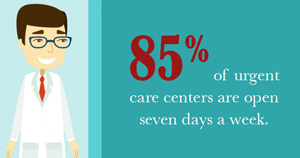
Imagine this: you’re hurt or sick, but you’re not sure if you need medical attention right away. Should you treat your symptoms at home? Should you make an appointment with your primary care physician? Should you go to the emergency room? Of course, this depends entirely on the severity of your medical condition and the associated pain.
Your first thought may be to visit your regular doctor; after all, she knows your medical history. Unfortunately, only 29% of primary care physicians offer after-hours coverage, and sometimes, it takes days or even weeks to get an appointment. If you are in severe pain or are concerned that your condition could worsen, it is essential that you seek medical attention immediately.
Fortunately, 85% of urgent care centers are open seven days a week and 95% of them are still open after 7 p.m. This is the best place to start.
Common Injuries Treated at Urgent Care
- Fractures: The most obvious sign of a fracture is pain. You may also experience swelling, bruising, or bleeding at the location of the fractured bone. Restricted movement is a sign of a fracture near a joint. A medical doctor may be able to identify a fracture just by looking at the area, but x-rays are usually required to make an accurate diagnosis.
- Whiplash: Whiplash is a neck injury that occurs from a forceful and rapid movement of the neck. This most often occurs during an auto accident but can also stem from a sports injury or physical abuse. Common signs of whiplash include neck pain and stiffness as well as headaches. Doctors usually treat whiplash with pain medication and exercise.
- Sprain: A sprain is defined as an injury to a ligament, which is the tissue that connects the bone to the joint. Sprains are usually caused by falling, twisting, or force. They are common in ankles, knees, fingers, and wrists. You will notice pain, swelling, and bruising at the site of the injury, and restricted movement at the joint. You may hear a pop or feel the tear when the injury occurs.
Common Illnesses Treated at Urgent Care
- Upper respiratory infection: The most common diagnosis at urgent care centers is an upper respiratory infection. This type of infection affects the nasal cavity, sinuses, throat, and larynx. There are many different types of upper respiratory infection, so the severity of the illness varies. The most common symptoms include nasal discharge, congestion, cough, sneezing, and fatigue.
- Urinary tract infection: UTIs usually occur due to bacteria in the urinary tract. While males and females of all ages can contract a UTI, it is most common in women. In fact, at least one-third of all women in the U.S. will have been diagnosed with a UTI by age 24. This type of infection can be easily treated with antibiotics, but in severe cases, the infection can spread to the bladder and kidneys, causing complications.
- Pink eye: Pink eye, or conjunctivitis, can be highly contagious. It is essential that you visit an urgent care center immediately if you have any of the following symptoms: blurred vision, fever, discharge from eye, itchy and watery eyes, redness in eyes.
Common Symptoms Treated at Urgent Care
You may not know for sure what is wrong, but if you are experiencing any of the following symptoms, it is certainly a good idea to have yourself checked out at an urgent care facility:
- Swollen glands
- Rash
- Minor abdominal pain
- Sore throat
- Headache
The above conditions and symptoms are best treated at an urgent care facility. The emergency room may sound like a quicker option, but it rarely is. Waiting times are usually much longer at the ER. In fact, studies show that patients who unnecessarily visited the ER would have spent an average of $784 less and saved nearly three hours by going to urgent care.
If you have any questions regarding urgent care or related illnesses and injuries, feel free to post in the comments section below.